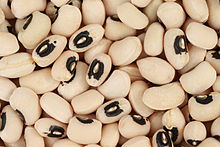Black eyed beans
| Black-eyed pea | |
|---|---|
 |
|
 |
|
| Ripe, opened black-eyed pea in pod associated with developing pods | |
| Scientific classification | |
| Kingdom: | Plantae |
| (unranked): | Angiosperms |
| (unranked): | Eudicots |
| (unranked): | Rosids |
| Order: | Fabales |
| Family: | Fabaceae |
| Genus: | Vigna |
| Species: | V. unguiculata |
| Subspecies: | V. u. subsp. unguiculata |
| Trinomial name | |
|
Vigna unguiculata subsp. unguiculata (L.) Walp. |
|
| Nutritional value per 100 g (3.5 oz) | |
|---|---|
| Energy | 484 kJ (116 kcal) |
|
20.76 g
|
|
| Sugars | 3.3 g |
| Dietary fiber | 6.5 g |
|
0.53 g
|
|
|
7.73 g
|
|
| Vitamins | |
| Thiamine (B1) |
(18%)
0.202 mg |
| Riboflavin (B2) |
(5%)
0.055 mg |
| Niacin (B3) |
(3%)
0.495 mg |
| Pantothenic acid (B5) |
(8%)
0.411 mg |
| Vitamin B6 |
(8%)
0.1 mg |
| Folate (B9) |
(52%)
208 μg |
| Vitamin E |
(2%)
0.28 mg |
| Vitamin K |
(2%)
1.7 μg |
| Minerals | |
| Calcium |
(2%)
24 mg |
| Iron |
(19%)
2.51 mg |
| Magnesium |
(15%)
53 mg |
| Manganese |
(23%)
0.475 mg |
| Phosphorus |
(22%)
156 mg |
| Potassium |
(6%)
278 mg |
| Sodium |
(0%)
4 mg |
| Zinc |
(14%)
1.29 mg |
|
|
|
|
|
| Percentages are roughly approximated using US recommendations for adults. Source: USDA Nutrient Database |
|
The black-eyed pea, black-eyed bean or goat pea, a legume, is a subspecies of the cowpea, grown around the world for its medium-sized, edible bean.
The common commercial variety is called the California Blackeye; it is pale-colored with a prominent black spot. In the American South there are countless varieties, many of them heirloom, that vary in size from the small lady peas to very large ones, as may be seen in the state and municipal farmers' markets. The color of the eye may be black, brown, red, pink or green. All the peas are green when freshly shelled and brown or buff when dried. A popular variation of the black-eyed pea is the purple hull pea; it is usually green with a prominent purple or pink spot. The currently accepted botanical name for the black-eyed pea is Vigna unguiculata subsp. unguiculata, although previously it was classified in the genus Phaseolus. Vigna unguiculata subsp. dekindtiana is the wild relative and Vigna unguiculata subsp. sesquipedalis is the related asparagus bean. Other beans of somewhat similar appearance, such as the frijol ojo de cabra (goat's eye bean) of northern Mexico, are sometimes incorrectly called black-eyed peas, and vice versa.
The first domestication probably occurred in West Africa, but the black-eyed pea is widely grown in many countries in Asia; it was introduced into the Southern United States as early as the 17th century in Virginia. Most of the black-eyed pea cultivation in the region, however, took firmer hold in Florida and the Carolinas during the 18th century, reaching Virginia in full force following the American Revolution. The crop would also eventually prove popular in Texas. Throughout the South, the black-eyed pea is still a widely used ingredient in soul food and various types of Southern U.S. cuisine. The planting of crops of black-eyed peas was promoted by George Washington Carver because, as a legume, it adds nitrogen to the soil and has high nutritional value. Black-eyed peas contain calcium (41 mg) folate (356 mcg), protein (13.22 g), fiber (11.1 g) and vitamin A (26 IU), among other nutrients, all for less than 200 Calories, in a 171-g, one-cup serving.
...
Wikipedia
